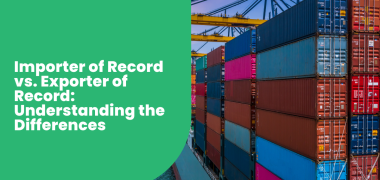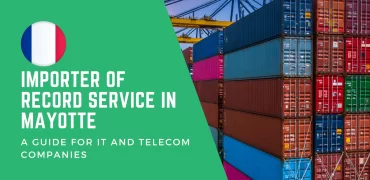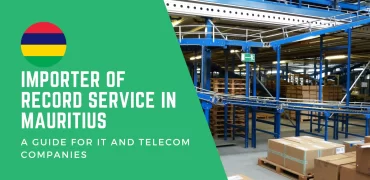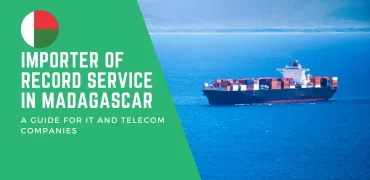In the complex world of international trade, two key roles stand out: the Importer of Record (IOR) and the Exporter of Record (EOR). These roles are essential in ensuring that goods move smoothly across borders, complying with various legal, regulatory, and logistical requirements. Understanding the differences between an IOR and an EOR is crucial for businesses engaged in global commerce. This blog post delves into the distinct responsibilities and functions of these roles, highlighting their significance in international trade.
Introduction to International Trade Roles
International trade involves a myriad of activities, from manufacturing and shipping to customs clearance and delivery. Central to these processes are the IOR and EOR, who play pivotal roles in the import and export of goods. These entities ensure that all legalities are met, duties are paid, and documentation is accurate and complete.
Defining the Importer of Record (IOR)
An Importer of Record (IOR) is a person or entity responsible for ensuring that imported goods comply with all local laws and regulations. The IOR assumes legal liability for the imported goods, including payment of duties and taxes, and ensures that all necessary documentation is submitted to the relevant authorities.
Responsibilities of the Importer of Record
- Regulatory Compliance: The IOR must ensure that all imported goods meet the local regulatory requirements, including product standards, safety regulations, and environmental laws.
- Customs Clearance: The IOR handles customs declarations, ensuring that all paperwork is accurate and submitted in a timely manner to facilitate smooth clearance.
- Payment of Duties and Taxes: The IOR is responsible for paying any import duties, taxes, and fees associated with bringing goods into the country.
- Record Keeping: Maintaining detailed records of the import process, including invoices, bills of lading, and customs declarations, is a critical function of the IOR.
- Product Classification: Accurately classifying goods according to the Harmonized System (HS) codes to determine the applicable duties and regulations.
Defining the Exporter of Record (EOR)
An Exporter of Record (EOR), on the other hand, is responsible for ensuring that goods being exported from a country comply with the export regulations of that country. The EOR handles the necessary documentation, ensures compliance with export control laws, and is accountable for the legal export of goods.
Responsibilities of the Exporter of Record
- Regulatory Compliance: The EOR must ensure that all exported goods comply with the exporting country’s regulations, including export controls and sanctions.
- Export Documentation: Preparing and submitting accurate export documentation, such as export declarations, commercial invoices, and packing lists, is a key responsibility of the EOR.
- Customs Clearance: The EOR manages the customs clearance process for exports, ensuring that goods are cleared for departure.
- Licensing and Permits: Obtaining any necessary export licenses or permits required for specific goods or destinations is a crucial function of the EOR.
- Record Keeping: Like the IOR, the EOR must maintain detailed records of the export process for compliance and audit purposes.
Key Differences Between IOR and EOR
While the roles of IOR and EOR may seem similar, they operate on opposite ends of the international trade spectrum and have distinct responsibilities:
- Jurisdiction and Scope:
- The IOR operates within the importing country, ensuring compliance with local import regulations and managing the import process.
- The EOR operates within the exporting country, ensuring compliance with local export regulations and managing the export process.
- Regulatory Focus:
- The IOR focuses on import regulations, customs duties, and taxes of the destination country.
- The EOR focuses on export regulations, including export controls, sanctions, and licensing requirements of the origin country.
- Documentation and Compliance:
- The IOR is responsible for import documentation, such as import declarations, bills of lading, and compliance certificates.
- The EOR handles export documentation, including export declarations, commercial invoices, and packing lists.
- Legal Liability:
- The IOR assumes legal liability for ensuring that the imported goods comply with all local laws and regulations, including payment of duties and taxes.
- The EOR assumes legal liability for ensuring that the exported goods comply with all export control laws and regulations, including obtaining necessary licenses.
Importance of IOR and EOR in International Trade
The roles of IOR and EOR are critical in ensuring the smooth flow of goods across borders. Their responsibilities help prevent legal issues, delays, and financial penalties, enabling businesses to operate efficiently in the global market.
Ensuring Compliance
Both the IOR and EOR ensure that goods comply with relevant laws and regulations, which is essential for avoiding fines, seizures, and other legal complications. Compliance with import and export regulations also ensures that goods are safe and meet the necessary standards.
Facilitating Customs Clearance
By handling the required documentation and declarations, the IOR and EOR facilitate the customs clearance process. This ensures that goods can move through customs smoothly and without unnecessary delays, which is crucial for maintaining supply chain efficiency.
Managing Duties and Taxes
The IOR’s responsibility for paying import duties and taxes ensures that all financial obligations are met. This is vital for the importing country’s revenue and for preventing any disruptions in the import process. Similarly, the EOR’s role in managing export compliance helps prevent penalties and ensures adherence to export control regulations.
Case Study: Effective Use of IOR and EOR
To illustrate the practical application of these roles, consider the case of TechSolutions, a mid-sized American technology firm expanding into international markets. TechSolutions leveraged both an IOR and EOR to manage their import and export processes efficiently.
TechSolutions’ International Expansion
TechSolutions partnered with GlobalTrade Solutions to act as their IOR and EOR. This strategic move enabled them to navigate the complexities of international trade and expand their market reach.
- Role of GlobalTrade Solutions as IOR:
- Ensured compliance with import regulations in various countries.
- Handled customs documentation and clearance.
- Managed payment of import duties and taxes.
- Provided local representation and support.
- Role of GlobalTrade Solutions as EOR:
- Ensured compliance with U.S. export regulations.
- Prepared and submitted necessary export documentation.
- Managed customs clearance for exports.
- Obtained required export licenses and permits.
Results
By leveraging the expertise of GlobalTrade Solutions, TechSolutions successfully expanded into multiple international markets. They experienced streamlined operations, reduced risks, and significant growth in revenue and market share. The effective use of an IOR and EOR enabled TechSolutions to focus on their core competencies while ensuring compliance with all legal and regulatory requirements.
Conclusion: Navigating International Trade with IOR and EOR
Understanding the differences between an Importer of Record and an Exporter of Record is crucial for businesses engaged in international trade. These roles are essential in ensuring regulatory compliance, facilitating customs clearance, and managing duties and taxes.
By partnering with experienced IOR and EOR service providers, businesses can navigate the complexities of international trade more efficiently and effectively. This strategic approach not only mitigates risks but also unlocks new growth opportunities in the global marketplace.
As international trade continues to evolve, the roles of IOR and EOR will remain integral to the success of businesses operating across borders. By understanding and leveraging these roles, companies can achieve smooth and compliant trade operations, driving their global success.




